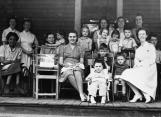1
At the end of the nineteenth century, increased sanitation and public health campaigns had strongly decreased the number of epidemics of diphtheria, cholera, scarlet fever and other contagious diseases common in unsanitary areas. On the other hand, however, cases of a paralytic illness were increasing, one which physicians knew little about. Also referred to as the "twentieth-century plague," poliomyelitis was seen in epidemic portions at this time and little was known about how to prevent its spread.Though cases of poliomyelitis, or infantile paralysis as also known, can be traced back to ancient Egypt, it had not been seen in such high epidemic levels before. Very few cases were occurring and the origins of the disease were still a mystery. Prior to the early twentieth century and increased sanitation reform, populations were exposed to the poliovirus, the cause of the disease, early on in their life when they still had maternal immunity to the virus. With increased sanitation, exposure to the virus was delayed and cases of the disease were more likely to be of the paralytic form of polio. The disease manifested itself in the form of flu-like symptoms and was often not cause for diagnosis until paralysis set in.
2
Victoria Public Hospital1890-1920
Fredericton, New Brunswick, Canada
 Credits:
Credits:Provincial Archives of New Brunswick Gillian Liebenberg Polio Years 1941-1954 collection: P384-96
3
Polio Patient in Polio Clinic1941-1954
Fredericton, New Brunswick, Canada
 Credits:
Credits:Provincial Archives of New Brunswick Gillian Liebenberg Polio Years 1941-1954 collection: P384-4
4
In 1937, New Brunswick experienced its first poliomyelitis epidemic and the majority of patients in the acute stage of the disease, who were still capable of infecting others, were placed in the isolation wing of the Victoria Public Hospital, which had seen patients housed there during epidemics of other infectious diseases. Most of the patients affected by polio, however, were young children and they were often separated from their parents during their stay in isolation with parents able to visit their children at the window.Many various treatments for poliomyelitis were tried during this period. One practice used was serum therapy which involved taking some blood from a newly recovered polio patient and injecting a polio patient as early as possible in a new patient in the hope that the blood injected included antibodies that could destroy the poliovirus. Other methods of treatment focused mainly around patients once they entered the rehabilitation phase of the disease.
5
Staff and Polio Patients at a Christmas Party1941-1954
Fredericton, New Brunswick, Canada
 Credits:
Credits:Provincial Archives of New Brunswick Gillian Liebenberg Polio Years 1941-1954 collection: P384-52
6
In 1941, the greatest polio epidemic struck New Brunswick, leaving the Victoria Public Hospital, one of the few hospitals in New Brunswick capable and willing to take in polio patients, overwhelmed with polio cases. Dr. Chalmers sent for help in Montreal and in September 1941, Kathleen Walker, a British-trained physiotherapist, accepted the offer of work and arrived in Fredericton. Together with Drs. Chalmers and Bell, they applied to convert an old nurses' residence into a polio clinic. The Asa Dow residence became the new home of the clinic in 1942 where post-polio patients (those that were no longer considered infectious after the virus left the body) were housed.Treatments in this facility focused mainly on rehabilitation and recovering as much mobility as possible. Such treatments included the Sister Kenny method of using hot packs and the use of hydrotherapy, a reliance on braces and crutches. After the arrival of Dr. Alexander Torrie in 1951, an orthopaedic surgeon, many post-polio patients underwent such surgery to remedy problems associated with the disease, mainly to do with regaining mobility.
7
Polio patients and Community1941-1953
Fredericton, New Brunswick, Canada
 Credits:
Credits:Provincial Archives of New Brunswick Gillian Liebenberg Polio Years 1941-1954 collection: P384-58
8
Dr. Alexander "Sandy" Torrie1951-1954
Fredericton, New Brunswick, Canada
 Credits:
Credits:Provincial Archives of New Brunswick Gillian Liebenberg Polio Years 1941-1954 collection: P384-13
9
In 1952, Dr. Chalmers and some other physicians like Dr. Joseph Alexander Bell advocated and pressured the government to build a new Polio Clinic. The old wooden building that housed the Clinic considered a fire hazard and a "disreputable old shack" by Dr. Chalmers. In 1955, the Provincial Government opened the new Provincial Polio Clinic and Health Centre. The new facility opened in the spring of 1955, around the same time as Jonas Salk's inactivated polio vaccine received approval for distribution. As the success of the vaccine led to a decrease of polio patients within the Clinic, more and more beds reserved for such patients were being allocated to other orthopaedic cases until the Clinic was amalgamated with the Victoria Public Hospital in 1967 due to a lack of bed space in the hospital.Though the Polio Clinic ceased to exist in the 1960s, the legacy of the disease as the centre for polio care within the province remains. The new Polio Clinic and Health Centre did not just cater to polio patients but included many other clinics such as a cancer and mental health clinics that contributed to the centralization of health services in central New Brunswick.
10
Polio patients and workers in front of Clinic1941-1954
Fredericton, New Brunswick, Canada
 Credits:
Credits:Provincial Archives of New Brunswick Gillian Liebenberg Polio Years 1941-1954 collection: P384-37
11
References and Other SourcesLiebenberg, Gillian. M.A. Thesis. "Disease and Disability: poliomyelitis, rehabilitation and social reform for disabled persons in New Brunswick, 1941-55." Fredericton: University of New Brunswick, 1994.
Macpherson, Kay and Christine Donald. When in Doubt, Do Both: The Times of My Life. Toronto: University of Toronto Press, 1994.
Rutty, Christopher. "The Middle Class Plague: Epidemic Polio and the Canadian State, 1936-1937." Canadian Bulletin of Medical History 13 no. 2 (1996):277-314.